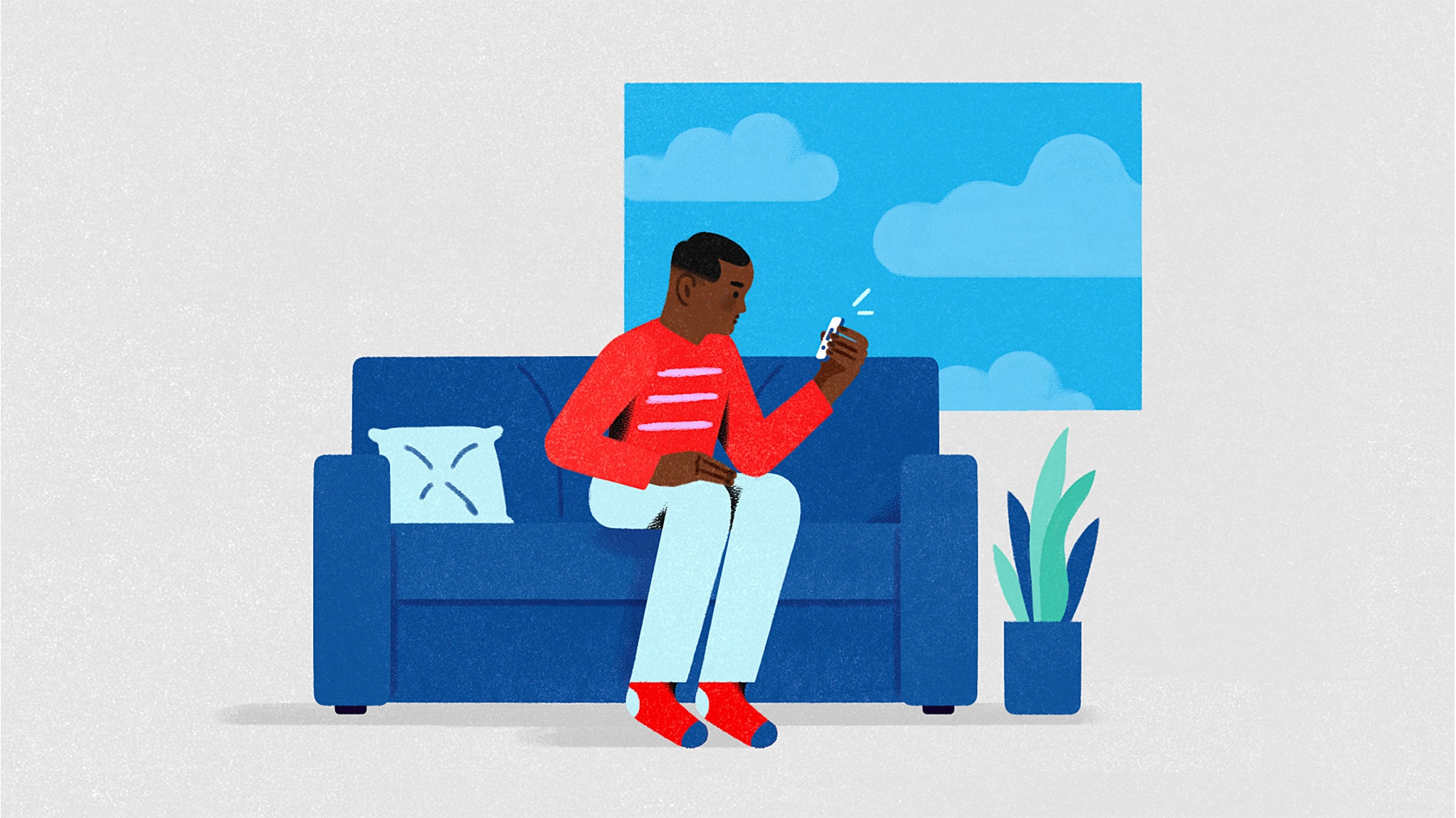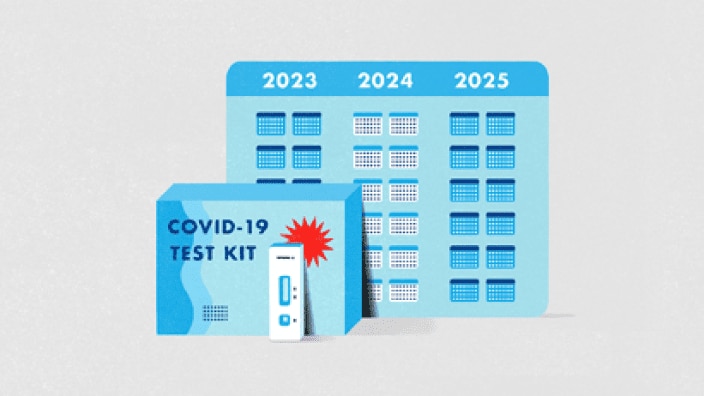How do at-home COVID-19 tests work? Here’s what to know.

Here is a cheat sheet on where to get at-home COVID-19 tests and when and how to use them.
In this article:
- What are COVID-19 symptoms?
- Frequently asked questions about at-home COVID-19 tests
- Do at-home COVID-19 tests expire?
- Does insurance cover at-home COVID-19 testing?
- Is it possible to get a false negative or false positive result?
- How do at-home COVID-19 tests work?
- What’s the difference between types of at-home COVID-19 test brands?
- What’s the difference between at-home tests and in-clinic testing?
- When should someone take an at-home COVID-19 test?
- Where to buy an at-home COVID-19 test
Coronavirus infections are still with us. Experts agree we’re going to be living with the presence of the virus for some time to come.1 Better news: We have multiples ways to help protect ourselves and our communities.
According to the Centers for Disease Control and Prevention (CDC), COVID-19 testing remains a vital step in managing the spread.2 Since November 2020, the Food and Drug Administration (FDA) has authorized COVID-19 at-home tests as a way to track the disease with self-testing in a convenient location.3
What are COVID-19 symptoms?
If a person is experiencing any COVID-19 symptoms or if they’ve been exposed to someone who has COVID-19, it’s a good idea to get tested. Typical COVID-19 symptoms include:
- Body aches
- Congestion
- Cough
- Diarrhea
- Fatigue
- Fever
- Headache
- Loss of smell or taste
- Nausea
- Shortness of breath
- Sore throat
- Vomiting4
The FDA recommends that people who have been exposed to COVID-19 wait at least five days from the time of exposure to take a test. They also recommend testing before coming into contact with someone who is high risk for severe COVID-19 (e.g., the elderly or those who are immunocompromised).5
Keeping at-home COVID-19 tests on hand is one way to help reduce the spread of coronavirus. Fortunately, there are a variety of ways to get at-home COVID-19 tests.
Frequently asked questions about at-home COVID-19 tests
COVID-19 remains an ongoing public health concern, although the number of active cases reported to the Centers for Disease Control (CDC) is generally declining. Please check the CDC for the most current recommendations and guidelines.6
Do at-home COVID-19 tests expire?
Yes. Most at-home tests have a shelf life of four to six months, but that may be extended based on new data. Check the FDA site for updated expiration dates.7
Are at-home COVID-19 tests covered by insurance?
As of May 11, 2023, when the Public Health Emergency ended, insurers are no longer required to cover the cost of over-the-counter COVID-19 tests, though some may choose to continue doing so.8
Can someone get false results?
Yes. It’s possible to get a false negative or false positive result when using an at-home test.9 Consult the product label and package for product-specific information and directions for use.
What’s the difference between at-home tests and in-clinic options?
Most at-home options are antigen tests, while laboratories can do antigen or polymerase chain reaction (PCR) tests, which are generally more accurate — but results can take several days.10
Do at-home COVID-19 tests expire?
Yes, at-home COVID-19 tests have expiration dates, and it’s important to pay attention to them. The FDA typically authorizes a shelf life of roughly four to six months.11, 12 But that shelf life may be extended based on new data.13
People can check the FDA website for updated expiration dates, including expiration dates for CVS Health® at-home COVID-19 test kits.14, 15
“If you use an expired test, you may not get an accurate result — most likely false negative — but it isn’t predictable, so it is best to avoid using an expired test,” explains Michael Chang, MD, UT Health Houston pediatric infectious disease expert affiliated with Children’s Memorial Hermann Hospital.16, 17
Does insurance cover at-home COVID-19 testing?
During the COVID-19 Public Health Emergency, most health insurance carriers were required to cover the cost of eight at-home COVID-19 tests per month.18 After this ended on May 11, 2023, insurers and their clients could make different coverage decisions based on the individual plan’s needs. Check with their insurance company to see what coverage for at-home tests may still be in effect.19
If a person is uninsured, they may be able to receive free testing at community-based test sites nearby.20
Is it possible to get a false negative or false positive result?
Yes. A false negative or false positive is possible.21, 22 Someone might test negative on an at-home COVID-19 test even if they are carrying the virus and whether or not they have symptoms.23
If the test results are negative, the FDA recommends two negative antigen tests for anyone with symptoms or three antigen tests for those without symptoms.24 The tests should be performed 48 hours apart.
Wondering what a positive at-home COVID-19 test looks like? Refer to the instructions that came with the test, because readings may differ brand to brand.
How do at-home COVID-19 tests work?
There are two types of at-home COVID-19 tests available for purchase: antigen tests and molecular tests. Antigen tests detect the presence of the COVID-19 virus in the nose. Molecular tests use a machine to increase and then measure the amount of COVID-19 genetic material present in the sample.25
All COVID-19 at-home test kits come with easy-to-follow instructions. Manufacturers’ instructions vary, so it’s important to follow instructions closely to get an accurate result.26
The top five reasons people took an at-home COVID-19 test
- They were exposed to COVID-19.
- They had COVID-19 symptoms.
- They weren’t feeling well.
- They were visiting family.
- They needed it for work or school.

What’s the difference between types of at-home COVID-19 test brands?
Most at-home COVID-19 rapid tests are antigen tests, which look for the presence of COVID-19 viral proteins in the nose.27 Check the product label to ensure the test is appropriate for the person taking it. (For example, most at-home COVID-19 rapid test brands are authorized for use in kids ages two and older [when an adult collects the sample] but not all are.28) According to Dr. Chang, most are nasal swabs with only minor differences in the time to get results.
Some at-home tests are molecular tests, which work in a similar way to laboratory-based PCR tests. By amplifying bits of genetic material, they are typically considered more sensitive than antigen tests.
In total, there are more than 20 at-home COVID-19 tests currently authorized by the FDA.
What’s the difference between at-home tests and in-clinic testing?
The difference is based less on where to get the test and more on what type of test to get, says Dr. Chang. With some exceptions, at-home COVID-19 tests are typically antigen tests.29 Laboratory tests can be either antigen tests or molecular tests. Molecular tests are generally more sensitive, meaning that false negatives are less likely to occur, especially when patients do not have symptoms.30, 31, 32
Dr. Chang notes that even if a clinic offers antigen testing, it’s possible the provider may be more skilled at collecting the sample, leading to a more accurate result. Keep in mind, laboratory results (especially for PCR tests) can take several days.33
When should someone take an at-home COVID-19 test?
If someone has COVID-19 symptoms, they should take a test immediately. Follow the instructions on the product packaging. If they use an antigen test and the results are negative, they should test again 48 hours later (for a total of two tests).34
If someone has been directly exposed to COVID-19 and doesn’t have symptoms, it’s still recommended that they take a COVID-19 test five days after exposure.35 If an antigen test shows negative results, they can take an additional test 48 hours after the first test.36, 37 If still negative, it is recommended to take a third test 48 hours after the second.
Taking more than one test is advised by both the FDA and the CDC.38 “The lower sensitivity of the at-home antigen tests means that sometimes you need multiple tests to be sure that you are truly negative,” notes Dr. Chang.
If any of at-home COVID-19 tests are positive, follow the CDC’s guidelines for masking, distancing and isolation precautions.
Where to buy an at-home COVID test
A variety at-home COVID-19 tests are available at most drugstores, including both in store and online through CVS Pharmacy®.
This content is for informational purposes only and is not medical advice. Consult your health care provider before taking any vitamins or supplements and prior to beginning or changing any health care practices.



